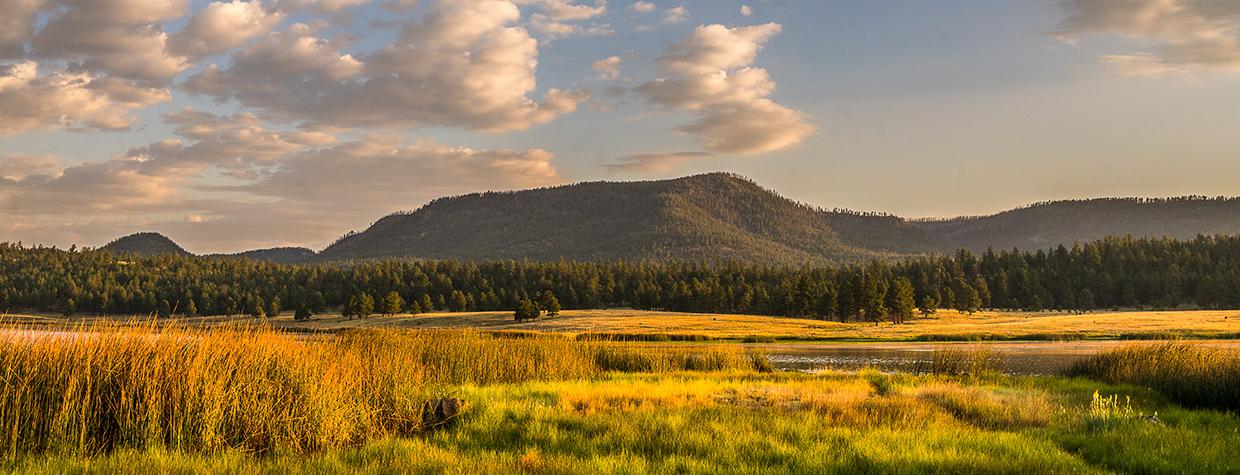In the 1930s, a trapper robbed Escudilla Mountain of what may have been Arizona’s last grizzly bear. And three-quarters of a century later, the Wallow Fire took much of what was left on the mountain. While grizzlies have yet to return to Arizona’s 12th-highest peak, the natural beauty lost during the 2011 blaze is making a dramatic comeback — and this mostly easy loop drive is an ideal way to experience it, especially in autumn.
The loop begins at the junction of U.S. routes 180 and 191 in Alpine. Heading east on U.S. 180, past Bear Wallow Café and the Mountain Hi Lodge, you’ll soon turn left onto County Road 2117, which initially is paved as it meanders past a few houses and a cemetery. The pavement quickly gives way to a well-maintained dirt road that runs north through tall ponderosa pines and small oaks just a few years old. You’ll also get a quick glimpse of Escudilla (Spanish for “bowl” or “basin”), which tops out at 10,912 feet, on the left.
At Mile 4 of the drive, the road enters the Apache-Sitgreaves National Forests and becomes Forest Road 275; a half-mile or so later, bear right at a “Y” intersection to stay on FR 275, which climbs a bit before descending into a heavily forested area with a steep drop-off on the left.
You’ll start seeing a few spruce trees amid the ponderosas and oaks, and by Mile 6, aspens begin to appear. If you’re leaf-peeping, be advised that the aspen leaves here reach their peak autumn hues in late September and early October. This area is the only rough stretch of road on the loop, and while it’s navigable in a sedan, you’ll be more comfortable in an SUV.
Next is a shallow creek crossing, followed by a stretch of road that parallels the creek on the left. From there, you’ll enter a verdant section of tall ponderosas, oaks and aspens, along with some downed trees, at Mile 10. From here on, you’ll see a number of log piles from forest thinning, but you’ll also see plenty of healthy trees that were spared by the largest wildfire in Arizona’s history.
The trees clear at Mile 12.5 to give you an excellent view of the north side of Escudilla, which is topped by naked ponderosa trunks but also abundant aspens and other greenery springing up to fill the void. A mile later, you’ll pass a thick aspen grove on the right, then curve into a section of more aspens, plus ponderosas and Douglas-firs.
The distinctive profile of Escudilla makes another appearance at Mile 14.8 before the road descends into another thick forest. The best view of the mountain, though, is at Mile 19.2, where a clearing offers a panorama of Escudilla framed by the smaller volcanic knolls on its flanks. Here, you’ll want to stop, make a few photos and maybe eat a slice of the pie you picked up from Bear Wallow.
From the panorama spot, it’s less than a mile to where FR 275 leaves the forest and becomes County Road 2116. After passing some houses on the right, this road traverses a grassy, juniper-dotted clearing before curving to the left and into a canyon of junipers and piñon pines.
Soon, you’ll be at U.S. 191 for a quick drive back to the starting point of the loop. You won’t see any grizzly bears. But you will see Escudilla Mountain, and that’s plenty.
tour guide
Note: Mileages are approximate.
Length: 39.5-mile loop (from Alpine)
Directions: From the intersection of U.S. routes 180 and 191 in Alpine, go east on U.S. 180 for 1.8 miles to County Road 2117. Turn left (north) onto CR 2117, which later becomes Forest Road 275 and then County Road 2116, and continue 23 miles to U.S. 191. Turn left onto U.S. 191 and continue 14.7 miles back to the starting point in Alpine.
Vehicle requirements: A high-clearance vehicle, such as an SUV or truck, is recommended, but four-wheel-drive is not necessary in good weather. Don’t attempt the drive after recent heavy rain or if rain is in the forecast.
Warning: Back-road travel can be hazardous, so be aware of weather and road conditions. Carry plenty of water. Don’t travel alone, and let someone know where you are going and when you plan to return.
Information: Alpine Ranger District, 928-339-5000 or fs.usda.gov/asnf

